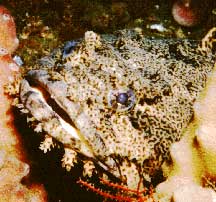Good Vibrations
Air Date: Week of January 9, 2004
Host Steve Curwood talks with Kuan Wang, chief of the lab at the National Institute of Arthritis and Musculorskeletal Diseases in Bethesda, Maryland about the special acoustic properties of the mating song of the male toadfish. They may offer clues to human nervous and muscular system diseases.
Transcript
CURWOOD: If looks alone are what wins a mate, the male toadfish would never get a date. But it’s their sound that brings females around. The toadfish is also known as the midshipman, and here to tell us about how he makes his love call is Kuan Wang. He’s the chief of the lab at the National Institute of Arthritis and Muscularskeletal Diseases in Bethesda, Maryland. Doctor Wang, welcome.
WANG: Thank you.
CURWOOD: Before we get to the findings of your study, would you please give us a picture of the toadfish? I’ve read that it has a face that only a mother could love.
 |
|
|
|
WANG: Well, okay, I’ll be kind and say that the fish is plain. Well, not really ugly and certainly not a flashy beauty like some reef fish. The fish spends most of its time burrowing in the sandy and dim ocean floor in the deep waters. So a sleek body and brilliant colors don’t really count for much.
CURWOOD: I understand that the toadfish has a pretty impressive mating ritual. Can you describe that? WANG: A male fish usually puts on very elaborate dances or changes color to win over females. Now, the midshipman male cannot dance and have no scales to change color. So it prefers not to be judged by its looks -- it actually resorts to singing to lure females. CURWOOD: Well, lets take a listen to that sound right now. [LOUD, VIBRATING HUM ] CURWOOD: You know, if I heard that I wouldn’t think it was a fish. In fact, as I understand it, when people were trying to figure out this strange noise on the California coast they thought that maybe aliens were landing or some power plant had gone out of whack. I guess these toadfish have made quite a reputation for themselves. WANG: Yeah, because the sound, the humming sound, sounds so much like man-made machine noise many residents suspected secret underwater military operations. So I think in 1977, through some very ingenious detective work, by an acoustic engineer and his friends, the secret agent man turned out to be this lonely toadfish in heat [laughs]. So now the community actually welcomes the summer residents by sponsoring annual humming toadfish festivals. CURWOOD: Now, what about the mechanism? What have you discovered about the mechanism of making this sound by the fish? WANG: It turns out the male has an air bladder which looks like an elastic balloon, but with two pieces of muscle attached to the surface. Now, these muscles are called drumming muscles because the vibration of these muscles changes the volume of the air bladder and therefore creates the soundwave. And it vibrates about a thousand times a minute. And this is easily rivaling the speed of, say, hummingbird wing beat frequencies or the speed the rattlesnake actually rattles its tail. The most amazing part of this is that the male can actually sing for a very long time. They can sing up to an hour or more without stopping. CURWOOD: Wow. WANG: That’s the amazing part. CURWOOD: So, I’m just wondering where this research might wind up. I’m wondering how likely is it that from this understanding of the toadfish muscles that we could make, say, heart muscles stronger, or make humans super strong. WANG: Actually, yeah. The special feature here is really a combination of the speed as well as endurance. So we think if we can understand the mechanism with which these structures assemble, we’ll actually be able to do reverse engineer these properties into human tissue, to coach some of the muscles in humans to work either faster, or work longer, or both. CURWOOD: Kuan Wang is chief of the Laboratory of Muscle Biology at the National Institute of Arthritis and Muscularskeletal and Skin Diseases. Dr. Wang, thank you for taking this time with me today. WANG: You’re very welcome. Thank you. CURWOOD: Coming up: Yes, we have no bananas – but we do have a story about how this fruit became the world’s most successful crop and efforts underway to keep it from going extinct. Stay tuned to Living on Earth. [MUSIC: Nickel Creek “Reasons Why” NICKEL CREEK (Sugarhill – 2000)] Living on Earth wants to hear from you!Living on Earth Newsletter [Click here]
Donate to Living on Earth! NewsletterLiving on Earth offers a weekly delivery of the show's rundown to your mailbox. Sign up for our newsletter today!
|





